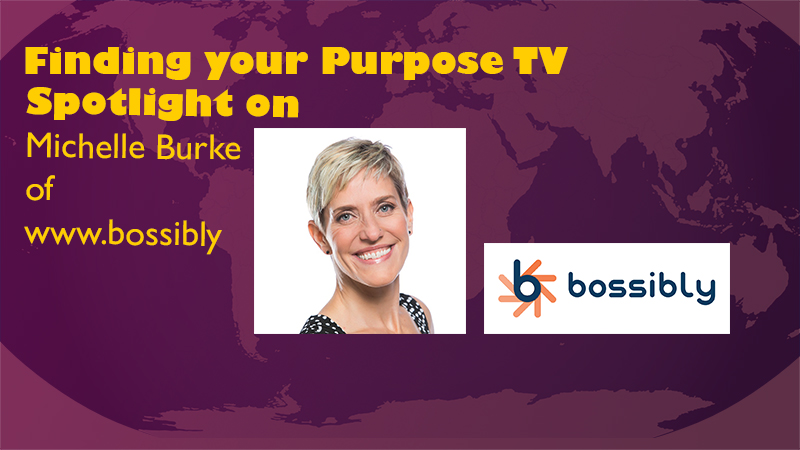Hello, this is Jane Gardner of finding your purpose, and today we’re on a mission to create awareness that being self-aware of your personality and your purpose in life, can you make you more intentional in your actions and bring you more success in your business, your relationships and your life? So let’s go. Welcome, everybody, to find your purpose. This is Jane Gardner and welcome. Today on our show, we have Michelle Burke of bossibly, and she aids young professionals and business leaders to become influential, influential leaders, to maintain the strength and core values, to help them create a culture of engagement which fosters predictable results and accountability.
And awesome. I love this idea. So welcome, Michelle. I’m just blown away by you have coming by. So thank you for coming. And thank you, Michelle.
Thank you for having me. Jane, I really appreciate it. It’s great to have a chat with you today.
That’s great. Michelle, one of my little things that I love to do is to ask how you got to where you are and what your purpose you feel is what you’re doing now and what your purpose is. So if you could give us an idea on that, Michelle, that would be great. That’s my little payment back for coming on to my interview.
Yeah, I would be happy to. So I have been coaching for years, even in corporate America. I love I have people coming to me for a problem, a problem. B, this is going on. Can you help me? And I think it was a couple of years ago, a former mentor of mine came to me and said, my daughter just graduated college, her master’s degree. She was working with a team. She’s now a leader in her own right. And he said, so she’s having trouble with this team. I know. I know I can help her, but I’m her dad. That’s probably going to end badly. I don’t think I should be mentoring my daughter as a leader. So would you be willing to help her? And I’m like, oh, I would be honored to do that, Mike. I would love to give back in that way. And then the same. And two days later, I had a friend of mine who’s a CEO of a business. She hires individuals and she said, I can attract them. I can hire them, but I can’t engage them and retain them. Do you have anything in your bag of tricks that you can give me to help me? And I’m like, this is a thing within two days, three days of one another, these things are happening like there’s something here. So that’s how it possibly was born. Wow.
Wow. Yeah.
I love the idea that you’re a mentor for for your friend, because I think a lot of people are just not aware of the need for having leadership training when you’re hired as as a manager or a leader. And, you know, it’s great that people are actually asking you. So this is amazing. Michelle, do you have an idea on maybe a story that you could tell us about one of your how you’ve been able to have the success that you’ve had with leadership training?
Yeah, so it’s a combination of training and coaching. And we were working with an organization right now who is scaling. And part of that scaling means that they’re looking at increasing the revenue going from a two million dollar business to a ten million dollar business. And that that in of itself is tricky. When you have people that do they understand the vision, the purpose for the organization. And so this woman owned business has wonderful people on her team. However, they’re not all. So let’s use the boat analogy. They’re all in the boat, but they’re not rowing in unison. There’s there’s challenges, there’s conflict. They’re not working together. They don’t understand their roles and responsibilities. And so while these they have great team members and teammates as part of this business. They’re not positioned to scale. They don’t have the processes in place, they don’t have the roles and responsibilities delineated for the different individuals, they don’t know how to handle conflict. And then they, the leaders of the business, are not showing up in a way to navigate where they should go and how they should get there.
Wow. So so what when you come in to talk to them, obviously you find out what’s wrong and then what’s what’s the first step. So they had no information on the roles and responsibilities of each of the team members. That’s that’s that’s correct.
Now it’s not good. And so the first step is usually some type of assessment.
Now, Jane, you and I were talking about the assessments are great. It gives you some insight to what’s happening, what’s happening, what’s going sideways, where should they focus first? And provided they have their mission and their vision, they know where they’re headed. And that and that they actually had that. They also we did a values exercise. So what is the organization’s values? So do they have the right people or are they aligned with the people on the bus? Do they have the right people with the right values on the bus? Are they working with the right clients? And there were some situations where they weren’t necessarily working with the right clients because quality is their number one value. And then they were doing projects for companies where those companies were cost focus and they were spending money, their own money on executing a project because quality was more important than the money for their clients. So that’s a problem. So those assessments help drive what’s going on in the business and where should we focus first? So what are those goals that we need to tackle and the actions? So a 90 day action plan to determine how we’re going to get where we need to be and what? I mean, there’s so many things you can do in a business, right? So you can’t do all the things. What’s going to make the most impact right now and how do you fix those things and then move further down the list?
Oh, wow. So you do do a directional evaluation as well as just finding out their values and who the people are that are working there. So so how do you work getting them to prioritize and make sure that is that with the values that you use, they use to find out what direction they should go and and what happens when you help them? Like how does it increase their income and business, though?
There’s a few pieces to that. The first piece is the profit and payback assessment. So they take that assessment, they take a value assessment and those will help us determine what their values are, what challenges exist in their business in order for us to ascertain where we should start. That’s provided that they have their vision and mission already. If they don’t have that and they don’t know where they’re headed and why, we start there and then build the values and then determine the goals, which ultimately creates that action plan and the action plan and that that 90 day action plan, as it’s measurable, it has dates. This is what you need to do in order to get where you need to go. That’s that’s the start of it.
Yeah, that’s amazing. Thank you. Because you were saying that you were able to increase million for one of your clients by working with this. What do you think really helped the most for them in their action plan to increase their income in the millions? I mean, that’s an amazing case study that you have.
So they’re still in process. They’re not they’re not to 10 million. They’re moving the needle, right? They’re moving the needle in the right direction from two million to three. But the the way to do that, there’s an amazing book. So those business owners that that need some assistance right now and there are some people like to do it on their own or some type. Sometimes they need help or they come to you or I write there’s a book called Profit First. And you need to know your numbers, meaning where where are you spending your money? Do you understand your cash flow? Have you assessed what’s coming in? What’s going out? Are you looking at I mean, making more money is important, but it’s just as important to see what you’re spending it on and and how you’re spending it. Should you be spending it? What is your what are your expenses look like? And have you captured that information and done the analysis to see where you need to go, what you need to cut? Are you paying yourself because so many businesses say, well, I just need more sales, I need more sales? Well, sales don’t necessarily translate into profit if you’re not managing your expenses. Right. I didn’t realize you were that practical.
That’s awesome, because I’m also a practical person having and being in business with my husband. We are all the time looking at your numbers, right? Yeah. Yeah. So, yeah. So this is very exciting to know that just by defining your values and finding out what the people are in your team, you can help with the communication. So what do you do with the leader? Do you do any private coaching with them as well just to make sure they’re on track or have you in this specific example?
What we did was have a leader, the leader, and what’s working within their team, what’s not working within their team. What do they see happening? Going well, going sideways, almost almost like treating it like a lessons learned current state. What’s what’s what’s happening right now. And one of the the pieces of advice that I. Give to the business owners and I’m working with provided they have a team of people underneath them, is to ask these three questions. These three questions are game changers. The first question is and this is so let’s let’s assume the leader, the business owner is the CEO or let’s assume they’re the CEO. And let’s say they have a team of eight or 10 people. The CEO can sit down one on one with each member of their team and ask these three questions. What should I start doing? What should I stop doing? And what should I continue doing? And so that then gives them information to understand. What their team may be, what they’re their subordinate, what that’s the team member, how they feel about what’s going on in the business and if they’re doing something wrong or if they’re doing something right, is there some sort of pet peeve or are they bothered in some way? And if they ask this question on a regular basis, they get the information to change behavior, to change their own behavior, to get the results from the teammates that are on their team head in the right direction.
Wow, that sounds great.
And of course, you must make make it a safe environment for the team to get together. And well, obviously, the team and each team member and the leader would get together. Personally, I don’t think they’d want to to hear any pet peeves and things in a team environment. But I’m sure you make a good environment for for all these conversations and show them to show them how to do it and make sure it’s safe. Good environment for them today.
I like to ask especially leadership coaches and advisors, what with the pandemic, how? Well, you know, right now, I mean, you don’t really need to change what you’re doing, but what are you finding in the in the time right now in terms of there must be a lot of anxiety from the leaders that you have to calm. And obviously, they’ve probably laid off a few people. I don’t know. But you’re in the environment. How’s it going with leaders right now in terms of the pandemic? Have you have you been able to work with them and help them ease their fears and all that kind of thing these days?
So I think there is a there’s a fair amount of fear that’s taking place. But that’s also there’s an opportunity for growth. So it’s not necessarily all fear based. It depends on how you use what lens you use. I suppose there are there are individuals that are leaders that that certainly have had to to let go staff. And I’ve seen this done well and I’ve seen this done poorly. The ones that are doing it well are having if if they have an environment, a positive culture, a positive climate, and they have an environment to trust, they’re able to share. So here’s here’s an example. One of the leaders that I’ve seen do this really well has said I’ve never been in a pandemic before. I don’t know how to handle this. I’m going to do the best I can. I’m going to be open and up front with you. I am really attempting to save everybody’s jobs and we are going to cut costs. We’re going to minimize how much we spend in other areas in order to keep the jobs to keep you on the team. And the minute that I feel that we’re going to have to do something different, I will let you know. And that’s the best I can do, is keep you in the loop, keep you keep open communication and keep the trust that I have with you today. And so that’s that and the opposite. What I’ve seen some leaders do is shut down, not communicate. They are paralyzed by the fear and they’re not sharing information or they cut a team member or two without the open dialogue. And then that puts the rest of the team on notice, like, oh, maybe I got to find another job. Oh, maybe I need to go somewhere else. So I think those are two very good examples of a good way to do it and the not so good way to do it.
Yeah, that’s great. Those are great examples. Thank you, Michelle, because, you know, a lot of people are thinking about this right now. And certainly there’s hope in the future and we’ll be happy to be working later. But I’m going to finish off here with showing people your assessment and where it’s located. Maybe you could. And they can also see your information about yourself. Maybe you could just mention a bit about the assessment and what it’s assessing. Of course.
Of course, though, this is the profit and payback assessment. And the what it is assessing is where are you at in your business? It talks about the money, the profitability of your business. It talks about vision and values, which we cover here today. It talks about your team. How, what, how how are you working with your team? Are you getting the most out of your people? And so and it also talks about your commitment to actually do anything about those areas that might be not so great in your business so that it is a what we like to call We would like to call this the you are here mall map for your business right now, if I know and a lot of people are going to all these days. But if you are in the mall and you go to the map, you have the little dot of, oh, I’m right here. So that is our way of helping businesses figure out where they’re at in their business profitability and payback with their team.
Oh, awesome. Awesome. Thank you, Michelle. I know. I know the time is is is about to expire and you’re very busy. So thank you for coming today on this. Very illuminating for me. I appreciate you talking about the pandemic. Even though it’ll be going away. There’s still leadership issues when it comes to in any crisis. So thank you very much for coming. And thank you, Michelle.
Thank you so much for having me, Jane. I really appreciate it. Yeah. So thank you. Thanks a lot, Michelle and next time we’ll be talking more in depth about leadership with Michelle, because I’ve got her. I’m hoping to come back in January with me. So thank you, Michelle.
You can check out Michelle’s free assessment at http:// profit and payback.Com, or for those who you need to spell it, it’s http colon, backslash, backslash p r o f i t a n dpay b a ck dot com. Thank you for listening.
For more on finding your purpose, go to https:// finding your purpose TV dot com and you can find us on Roku and finding your purpose as well. You can find us on YouTube. Look for finding your purpose. See you there.




